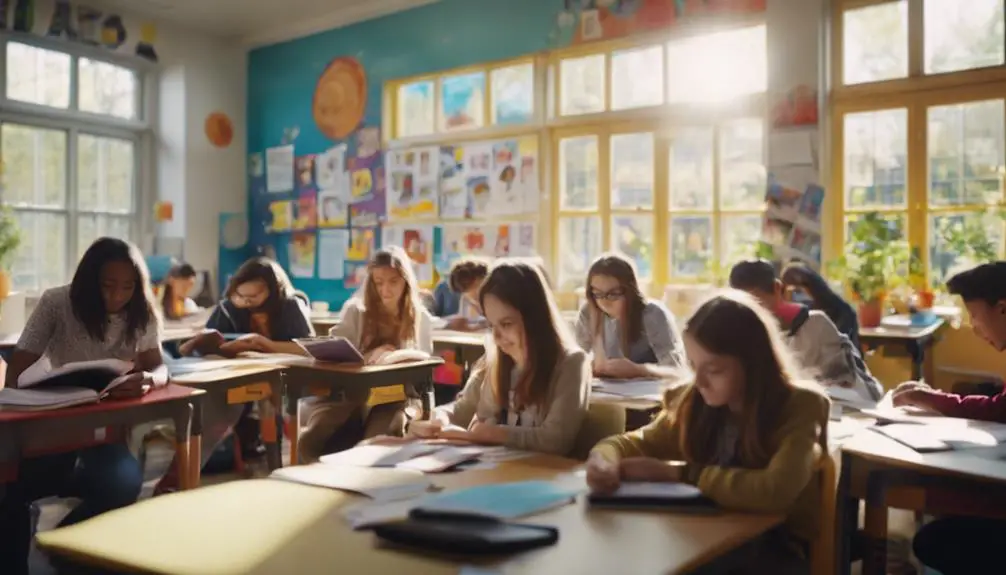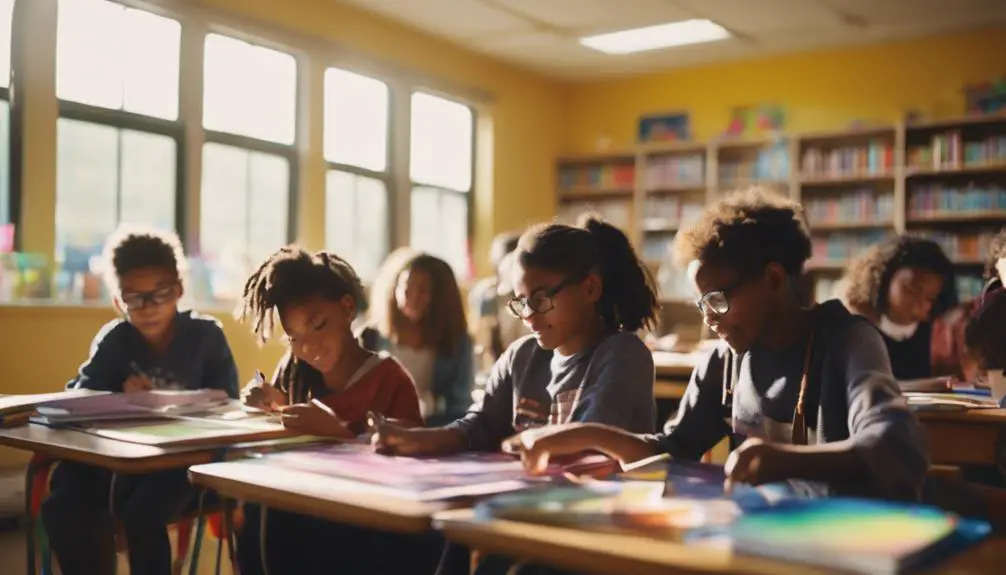For introverted educators, managing a classroom effectively can pose a challenge. However, there are specific strategies that can help capitalize on our strengths and foster a positive learning environment.
From handling student interactions to setting clear boundaries, thriving in classroom management as an introverted teacher is not only achievable but can also enhance the overall teaching experience.
How introverted teachers can succeed in classroom management

For introverted teachers, successful classroom management involves creating a calm classroom atmosphere, prioritizing personalized student interactions, and engaging in thoughtful lesson planning.
Understanding and empathizing with students’ needs and preferences, along with incorporating small group activities, can help introverted teachers effectively manage their classrooms while playing to their strengths.
Quiet Classroom Environment
Creating a peaceful classroom environment is crucial for introverted teachers to effectively manage their students while staying true to their natural tendencies. To foster a quiet classroom atmosphere, consider incorporating the following strategies:
- Use Silent Signals: Utilize non-verbal cues to communicate with students.
- Designate Calm Corners: Set aside a quiet area where students can relax or refocus.
- Incorporate Mindful Movement: Integrate gentle movements or stretching exercises to encourage tranquility.
- Develop Quiet Cues: Create subtle ways to redirect behavior without disturbing the overall quiet ambiance.
- Ensure Peaceful Transitions: Transition smoothly between activities to uphold a sense of peace and order in the classroom.
Personalized Student Interactions
As an introverted teacher, I focus on building strong connections with my students to manage my classroom effectively. Providing personalized feedback allows me to understand each student’s unique needs and adjust my teaching approach accordingly. This tailored support helps foster student engagement and cultivates a positive learning environment.
Thoughtful Lesson Planning
Crafting well-structured lesson plans is essential for introverted teachers to effectively manage their classrooms. When preparing lessons, I focus on creating activities that engage students and cater to various learning styles.
Here are some key elements I include in my lesson plans:
- Interactive activities: I encourage all students to participate and get involved.
- Student engagement: I strive to keep students interested and motivated throughout the lesson.
- Creative assignments: I aim to inspire creativity and critical thinking skills in students.
- Collaborative projects: I foster teamwork and communication among classmates.
- Differentiated instruction: I adapt teaching methods to meet the diverse needs of students.
Empathy and Understanding
Understanding the specific needs and viewpoints of students is crucial for introverted teachers to excel in managing their classrooms.
Practicing empathy exercises can help us establish deeper connections with our students, fostering a sense of trust and mutual respect.
By actively listening and empathizing with different perspectives, we can adapt our teaching methods to accommodate the diverse requirements of our students.
Responding with empathy and showing emotional intelligence can significantly contribute to building strong relationships with our students, cultivating a supportive and inclusive classroom environment.
Through these approaches, introverted teachers can effectively handle classroom dynamics while nurturing positive interactions with their students, ultimately creating a conducive learning atmosphere for all.
Small Group Activities
Establishing small group activities in the classroom allows introverted teachers to effectively manage their classrooms while leveraging their strengths in fostering meaningful connections with individual students.
Small group activities provide a conducive environment for nurturing essential skills such as team building, problem-solving, communication skills, critical thinking, and collaboration techniques. Through these activities, students can work together, learn from one another, and develop a sense of camaraderie.
As an introverted teacher, I find that small group activities not only create a more manageable classroom dynamic but also enable me to engage with students on a more personal level, catering to their individual needs and helping them thrive academically and socially.
Encouraging Student Participation
Being an introverted teacher focused on classroom management, my method to encourage student participation revolves around creating a supportive and inclusive environment that values individual contributions. Student engagement is crucial, so I incorporate participation strategies like interactive learning activities to encourage involvement and foster active participation.
Providing opportunities for students to share their thoughts and ideas in a safe space helps them feel more comfortable participating. By using various interactive learning techniques such as group discussions, peer teaching, and hands-on activities, I aim to cultivate a classroom atmosphere where every student feels valued and motivated to engage.
Encouraging active involvement not only enhances the learning experience but also helps in creating a sense of community within the classroom.
Positive Reinforcement Techniques
As an introverted teacher, effectively managing a classroom involves using positive reinforcement techniques to create a supportive and encouraging learning environment. Reinforcement strategies are essential for behavior modification and student motivation. Here are some practical ways to implement positive reinforcement:
- Give verbal praise for good behavior
- Provide small rewards for completing tasks
- Use a points system to acknowledge positive actions
- Establish a reward system for achieving goals
- Introduce a class-wide incentive program
Creating Safe Spaces
Creating a safe space in my classroom as an introverted teacher involves establishing a nurturing environment where students feel valued and respected. I prioritize building trust through open communication and attentive listening.
Providing emotional support is key as I seek to understand each student’s unique needs and concerns. When conflicts arise, I approach them with patience and empathy, encouraging students to express themselves constructively.
Building Strong Relationships
Developing authentic connections with students is crucial for introverted teachers to excel in managing their classrooms. The key components of building strong relationships include fostering trust, honing communication skills, resolving conflicts, nurturing emotional intelligence, and cultivating rapport.
- Trust Building: Emphasize honesty and consistency to establish trust with students.
- Communication Skills: Improve active listening and clarity in communication to ensure mutual understanding.
- Conflict Resolution: Promote open discussions and teach effective problem-solving strategies.
- Emotional Intelligence: Cultivate self-awareness and empathy to address students’ emotional needs.
- Building Rapport: Invest time in getting to know each student individually to create a supportive and inclusive learning environment.
Utilizing Technology Effectively
Using technology effectively in classroom management helps introverted teachers engage students better and handle administrative tasks more efficiently. Integrating technology is vital for creating interactive learning experiences. Online tools can foster collaboration and connection among students in the classroom. Digital resources offer various ways to present information, catering to diverse learning styles.
Virtual platforms also allow introverted teachers to communicate and share ideas with their peers comfortably. While keeping screen time limits in mind, incorporating technology into lessons brings significant educational benefits. By strategically utilizing digital resources, introverted teachers can establish a dynamic and engaging learning environment that supports their teaching style and meets the diverse needs of their students.
Providing Clear Instructions
In my approach to classroom management as an introverted teacher, I prioritize giving clear and concise instructions that cater to the diverse learning styles of my students. This clear communication is essential for engaging students and helping them comprehend the tasks at hand.
By providing effective guidance and actively listening to my students, I can better understand their individual needs. Setting clear expectations also promotes student accountability, while offering straightforward directives encourages their active involvement in the learning process.
These strategies help me create a structured and inclusive learning environment where students feel supported and empowered to succeed.
Implementing Visual Aids
Integrating visual aids into my classroom management approach as an introverted teacher improves student comprehension and engagement. By using interactive presentations and creative displays, I encourage student participation, making lessons more memorable.
Vibrant visuals not only spark interest but also aid in retention, helping students grasp concepts more effectively. Through the use of multimedia resources, I provide instructional support that accommodates various learning styles, ensuring all students can engage with the material.
These engagement strategies not only enhance the learning process but also cultivate a dynamic and inclusive classroom atmosphere where students feel actively involved in their educational journey.
Establishing Routines and Expectations
Establishing clear routines and expectations is a key aspect of my classroom management approach as an introverted teacher. This helps create a structured learning environment that supports student engagement and success.
To achieve this, I focus on maintaining consistency, holding students accountable for their actions, promoting independence, encouraging engagement through interesting activities, and building trust with students.
These routines and expectations provide stability, responsibility, self-reliance, interest, and a trusting relationship that enhances the overall learning environment.
Embracing Individuality
Embracing individuality means valuing the unique strengths and perspectives that introversion brings.
When it comes to classroom management, I prioritize making personalized connections and providing tailored support to each student.
By focusing on self-care practices like quiet reflection, I aim to develop emotional intelligence and create strategies that meet the individual needs of every student.
This approach helps students thrive by addressing their specific requirements in a supportive and personalized manner.
Incorporating Mindfulness Practices
Creating a mindful classroom environment as an introverted teacher involves incorporating calming practices that help students focus and regulate their emotions. To establish a peaceful atmosphere, I use the following techniques:
- Mindfulness Practices: I introduce short mindfulness exercises during transitions.
- Self Care Strategies: Students are encouraged to practice self-care routines like deep breathing.
- Relaxation Techniques: I include brief relaxation moments in our daily schedule.
- Stress Management: Teaching students strategies for stress management, such as progressive muscle relaxation.
- Mindfulness Exercises: Guiding students through mindfulness activities to improve their focus and awareness.
Effective Communication Methods
As an introverted teacher managing a classroom effectively, I focus on using communication methods that suit my natural tendencies and strengths while creating a positive learning environment for my students. By actively listening and paying attention to nonverbal cues, I can better understand my students, improve communication, and build strong connections with them.
I find that utilizing digital communication tools and offering written feedback allows me to express my thoughts clearly and ensure that my message is easily understood. In instances of conflict, I rely on de-escalation techniques and conflict-resolution strategies to maintain a peaceful classroom atmosphere.
Encouraging collaborative projects among students not only enhances group dynamics but also fosters teamwork skills. Additionally, through assertiveness training, I’ve learned various communication styles that help me confidently and effectively express myself in different classroom situations.
Balancing Listening and Speaking
As an introverted teacher managing classroom dynamics, striking a balance between active listening and clear verbal communication is crucial for effective classroom management. This balance involves demonstrating the value I place on students’ thoughts and opinions through active listening.
I also foster a collaborative learning environment by encouraging interactive discussions. Engaging students with hands-on tasks helps keep them motivated and involved. Reflecting on my teaching methods and making necessary adaptations is a key aspect of maintaining this balance.
Mindful communication, where I carefully choose words to ensure clarity and understanding, plays a vital role in successful classroom interactions.
Utilizing Peer Collaboration
Utilizing peer collaboration in classroom management as an introverted teacher involves using cooperative learning strategies to boost student engagement and create a supportive learning environment.
Peer support plays a vital role in fostering positive interactions among students. Activities like team projects not only encourage active participation but also help in developing crucial social skills. Understanding how groups work in the classroom can help introverted teachers promote cooperative behavior among students effectively.
By integrating peer collaboration, introverted teachers can establish an environment that encourages teamwork and mutual respect, leading to a harmonious and engaging learning atmosphere.
Flexibility in Teaching Approach
Adapting my teaching approach to meet the diverse needs of students has been crucial to my success as an introverted teacher in effectively managing the classroom. Embracing flexibility allows me to customize lessons to address individual student requirements, fostering engagement and active participation.
Through the use of varied instruction techniques, I can accommodate different learning styles in the classroom, ensuring that each student has the opportunity to excel. By incorporating a range of activities that align with student interests, I not only create a dynamic learning environment but also cultivate a passion for learning.
Tailoring my approach based on students’ unique learning styles helps strengthen the connection between the material and the individuals. Remaining adaptable in response to changing classroom dynamics promotes a harmonious and productive learning environment.
Promoting Self-Reflection
In my teaching practice as an introverted teacher, I focus on self-reflection to improve my classroom management skills. I encourage my students to engage in activities that promote introspection, such as journaling prompts, moments of quiet reflection, mindfulness exercises, and activities aimed at personal growth and self-awareness. By guiding students through reflection, they gain a deeper understanding of themselves and their behaviors, leading to better academic performance and behavior. Here are some strategies to incorporate self-reflection in the classroom:
| Self-Reflection Activities | Description |
|---|---|
| Journaling prompts | Writing prompts for self-expression and exploration |
| Quiet reflection | Moments of silence for introspection and mindfulness |
| Mindful exercises | Breathing exercises or mindfulness activities for focus |
| Personal growth | Goal-setting and tracking progress for self-improvement |
| Self awareness | Activities to enhance understanding of emotions and behaviors |
Encouraging Creativity and Autonomy
As an introverted teacher, I’ve found that nurturing creativity and independence in students is crucial for effective classroom management. To achieve this, I encourage:
- Individual projects: Allowing students to work on their own projects promotes self-expression.
- Creative opportunities: Providing chances for creative expression increases engagement and enthusiasm.
- Student empowerment: Giving students the freedom to make decisions fosters responsibility and a sense of ownership.
- Tailored learning: Customizing tasks based on students’ interests and abilities enhances their educational experience.
- Self-guided learning: Inspiring students to take control of their learning journey cultivates independence and critical thinking skills.
Managing Classroom Energy
Navigating the energy in the classroom as an introverted teacher involves understanding student dynamics to create a peaceful learning environment that suits our natural teaching style. Managing classroom energy requires a careful balance of energy levels, subtle engagement, personalized approaches, meaningful interactions, and empathetic insight. By tuning into students’ cues, we can adjust our teaching techniques to meet their needs while honoring our introverted tendencies. Here are practical strategies for introverted teachers to effectively manage classroom energy:
| Effective Strategies for Managing Classroom Energy |
|---|
| 1. Observe group dynamics |
| 2. Utilize non-verbal signals for guidance |
| 3. Offer quiet spaces for reflection |
Setting Boundaries Respectfully
As a teacher who values successful classroom management, it’s crucial to set boundaries respectfully to foster a positive learning environment that aligns with our teaching approach. When establishing boundaries, remember to:
- Be clear in your communication: Express your needs and expectations openly.
- Maintain healthy boundaries: Strike a balance between being available and preserving personal space.
- Enforce discipline respectfully: Implement consequences calmly and consistently.
- Demonstrate professionalism: Model integrity and professionalism in all your interactions.
- Set clear expectations: Ensure students understand the rules and consequences from the start.
Leveraging Student Strengths
In classroom management, leveraging student strengths as an introverted teacher involves recognizing and empowering individual abilities. Encouraging student collaboration, adopting a strength-based approach, and providing differentiated instruction are key strategies to create an inclusive learning environment.
By promoting teamwork and peer support, students can enhance their learning experience. Emphasizing and building on each student’s strengths fosters growth and confidence. Additionally, adapting teaching methods to cater to diverse learning styles ensures that all students can engage effectively.
These approaches not only improve learning outcomes but also cultivate a sense of community within the classroom.
Fostering a Sense of Community
To create a sense of belonging and connection in the classroom as an introverted teacher, it’s important to focus on building genuine relationships and fostering open communication with students. Developing a strong community involves paying attention to group dynamics and working on building trust. Here are some strategies to help cultivate a sense of community in the classroom:
- Encouraging Community Building: Promote teamwork and mutual support among students.
- Understanding Group Dynamics: Recognize the different roles individuals play in a group to enhance collaboration.
- Building Trust: Establish a safe space where students feel comfortable sharing their thoughts and ideas without fear of judgment.
- Fostering Connections: Show a genuine interest in your students’ lives and well-being.
- Teaching Collaboration Skills: Help students learn how to work together effectively towards common goals.
Conclusion
To sum up, introverted teachers can excel in managing their classrooms by accepting and embracing their quieter nature and implementing strategies that align with their strengths.
Finding a balance between moments of solitude and engaging with students can foster a peaceful and conducive learning atmosphere where students can thrive.
Just like a tranquil stream meandering through a bustling city, introverted teachers can bring a sense of calmness and organization to the classroom, guiding their students toward growth and exploration.
















